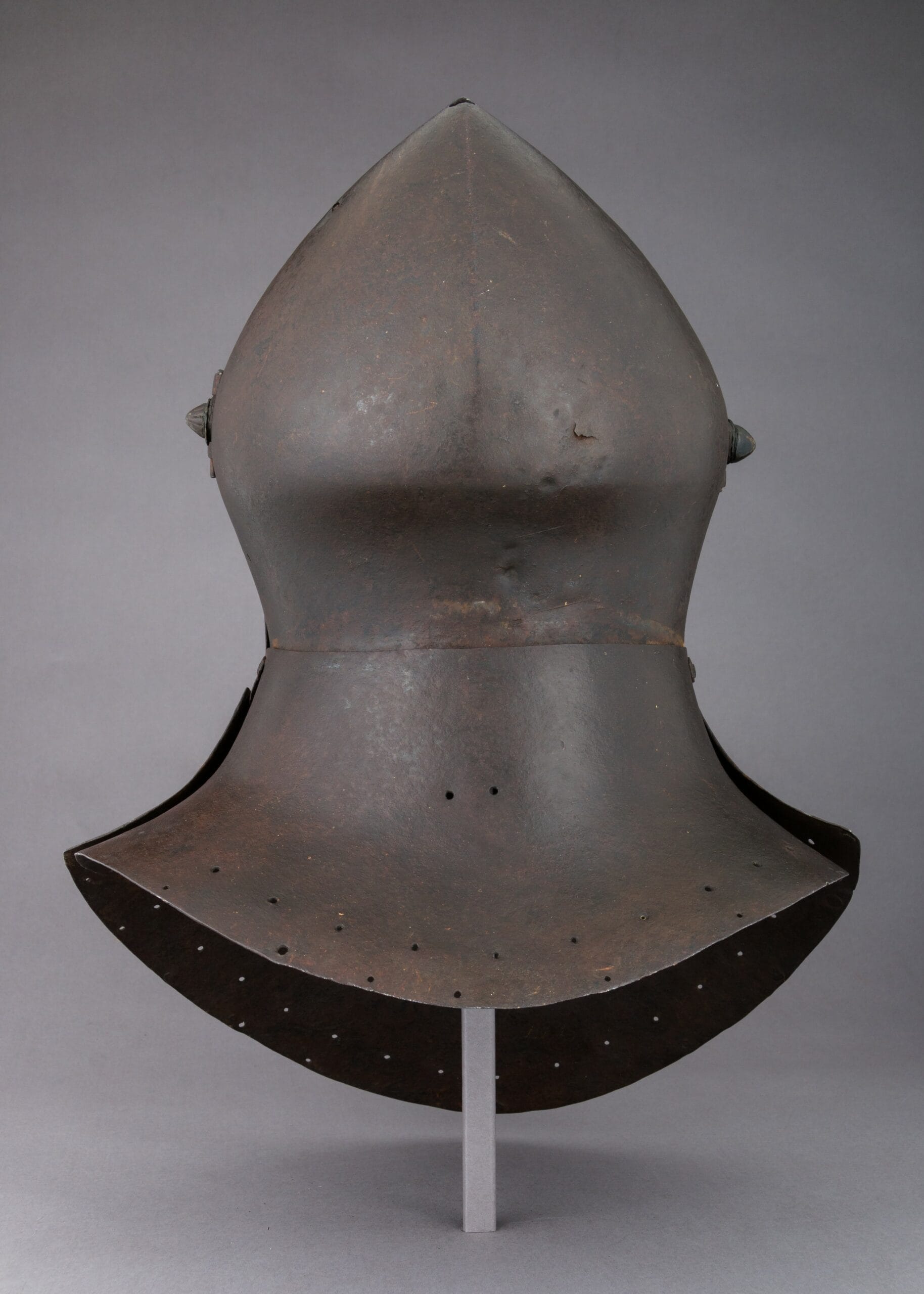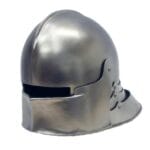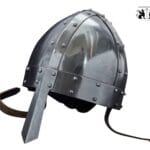Picture a medieval battlefield: the clash of steel, the thunder of hooves. Amidst the chaos, one piece of equipment stands out—the bascinet. This iconic helmet, far from a simple metal covering, represents a fascinating journey of evolution, craftsmanship, and cultural impact, profoundly shaping medieval warfare and knightly identity. Join us as we delve into the history of the bascinet, exploring its origins, design, usage, and enduring legacy.
From Skullcap to Icon: The Bascinet’s Evolution
The bascinet’s story begins in the late 13th century, evolving from the simple cervelliere, a skullcap worn beneath chainmail. First recorded in Padua, Italy in 1281, worn surprisingly by infantry, the bascinet quickly gained popularity. By the 14th century, it had become synonymous with mounted knights. This transformation wasn’t instantaneous. The cervelliere gradually extended downwards, offering increasing protection to the head and neck, eventually developing into the early bascinet [https://www.lolaapp.com/]. Its design, however, was far from static.
A Period of Transformation: Design and Development
Between 1390 and 1410, the bascinet underwent a period of exaggerated design. Think towering helmets with acutely pointed profiles, sometimes near-vertical at the back, almost alien in appearance compared to later iterations. This design probably offered extra protection against downward blows. Following this phase, practicality prevailed. From 1410 onwards, the skull and hinged visor became less angular and more rounded, optimizing for both protection and visibility. This shift might also reflect changes in combat styles and weaponry [https://www.lolaapp.com/].
One of the most distinctive features of the bascinet is the visor. The late 14th and early 15th centuries saw the development of the “pig-faced” or “hound’s skull” visor. This uniquely shaped visor, particularly favored by English knights, offered excellent vision and breathing room while safeguarding the face. Often elaborately decorated, it showcased the artistry of medieval metalwork.
Forging a Masterpiece: Construction and Key Features
Crafting a bascinet was a testament to the skill of medieval artisans. Primarily forged from iron or steel, the bascinet incorporated several crucial components. The aventail, a mail curtain attached to the lower edge, shielded the knight’s throat and neck, a vulnerable area often targeted in combat. Protecting the lower face and chin was the baviere, a piece of plate armor often worn with a plate gorget, further enhancing neck protection, as seen in depictions of Henry V at the Battle of Agincourt. And of course, the visor, evolving through numerous forms, played a crucial role in balancing vision and defense. Each element contributed to the bascinet’s effectiveness in the brutal realities of medieval warfare.
The Bascinet at War: Impact and Tactics
Initially adopted by infantry, the bascinet was quickly embraced and adapted for mounted knights. Early bascinets (excluding the larger great bascinets) were even designed to be worn under a great helm, providing layered protection. This adaptability made the bascinet a versatile piece of armor, suited for various combat scenarios. The bascinet’s influence on medieval warfare goes beyond mere protection. It significantly impacted battlefield tactics. With their heads and faces well-protected, knights could lower their heads and charge with lances, forming devastating formations that revolutionized medieval cavalry tactics. The bascinet, therefore, wasn’t just defensive armor; it was a catalyst for tactical innovation.
Beyond Protection: Symbolism and Status
The bascinet transcended its functional purpose to become a powerful symbol of knighthood, social status, and artistic expression. Knights often personalized their helmets with elaborate crests, intricate engravings, and decorative plumes, transforming them into personalized works of art reflecting their heraldry and family connections. This customization served not just aesthetic purposes but also practical ones on the chaotic battlefield, aiding in identification before the widespread adoption of standardized uniforms.
The Waning of an Era: The Bascinet’s Decline
The bascinet’s dominance waned around the mid-15th century. This decline coincides with a period of significant military innovation, with the emergence of new weapons and armor. While pinpointing the exact moment of its obsolescence is difficult, the introduction of the armet, a fully enclosed helmet offering improved protection, and the sallet, known for its distinctive shape and comfort, presented formidable competition. These lighter, more maneuverable alternatives gradually supplanted the bascinet on the battlefield. By the late 15th century, though possibly still used ceremonially or by less equipped soldiers, the bascinet’s reign as the primary battle helmet had ended.
Unveiling the Past: Ongoing Research and Unanswered Questions
While much is known about the bascinet, ongoing research continues to reveal new insights into its design, production, and cultural significance. Historians are exploring various aspects, from regional variations in craftsmanship and decoration, to how evolving metallurgical practices influenced its development. Some experts suggest that bascinet use may have been more widespread than currently believed, particularly among different social classes during periods of intense warfare. Areas of ongoing study include the specifics of how the shift to other helmet types came about and the detailed evolution of the design features of the bascinet. By examining surviving examples and historical records, researchers aim to create a richer, nuanced understanding of this iconic helmet.
Who Wore the Bascinet? Knights, Men-at-Arms, and Beyond
The bascinet was undoubtedly the quintessential helmet for knights and men-at-arms. These professional soldiers relied on its balance of protection and mobility, crucial for both mounted combat and close-quarters fighting. The extent of its use by other groups, such as foot soldiers or civilians, remains an area of ongoing research. While less common, it’s certainly plausible that others adopted bascinets for protection during times of conflict. Further investigation, including analysis of historical records and archaeological discoveries, will paint a clearer picture of the bascinet’s distribution across medieval society.
If you’re interested in medieval weaponry, you might also want to explore the basket hilt sword and the basket hilted broadsword, both of which offer insights into the evolution of medieval combat.
The bascinet remains a powerful symbol of the medieval era, a testament to the ingenuity of medieval craftsmen and a window into the complexities of medieval warfare. It is more than just a helmet; it is a story of adaptation, innovation, and the enduring human drive for protection and self-expression.
- Georgia Platform: A Southern Strategy, 1850s - March 31, 2025
- How many weeks is 40 days: Quick Conversion Guide for Accurate Results - March 31, 2025
- How many feet is 300 meters? 984 Feet: Understand Length Conversions Easily - March 31, 2025
















